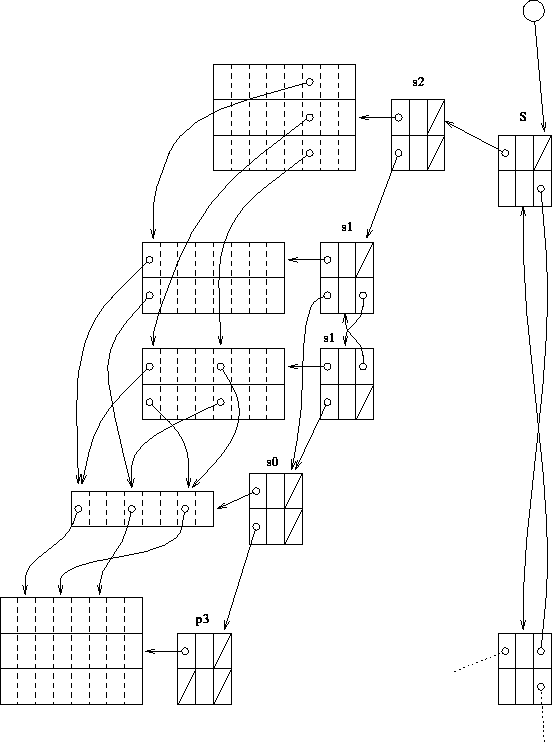5.4.2 Data Structures





Next: 5.5 Flow-Lines
Up: 5.4 Implementation
Previous: 5.4.1 Supported Operations
The internal memory resident representation of the visualization data
is the so-called VISTA Visualization Format, or VVF.
It implements directly the simplex concept
using a set of hierarchical C data structures, which
are passed from module to module.
The structures are organized in dynamically allocated arrays
of simplexes or coordinates.
A doubly linked list of tagged blocks which point to
the arrays of simplexes
is maintained.
The  -simplex data structure consists of
-simplex data structure consists of  references to
references to
 -simplex data structures, an attribute field and an
auxiliary pointer, which can be used by individual visualization modules for
back-referencing and similar purposes.
The attribute is an integer value which is
interpreted by the output tools; it can be mapped to graphical
properties like color, texture, or line style, depending on the output
device.
-simplex data structures, an attribute field and an
auxiliary pointer, which can be used by individual visualization modules for
back-referencing and similar purposes.
The attribute is an integer value which is
interpreted by the output tools; it can be mapped to graphical
properties like color, texture, or line style, depending on the output
device.

Figure 5.2: Simplified arrangement of VVF structures
for a set of two-dimensional simplexes.
Figure 5.2 shows an example of a VVF structure consisting
of simplex arrays and blocks. It represents a simple example for a
two-dimensional simplex set. The block labeled ``s2'' represents the
2-simplexes (triangles) which reference lines of the ``s1'' block. The
``s1'' block consists of multiple simplex arrays. The zero-simplexes
in the ``s0'' block are just references to the coordinate tuples of
the point block. This might appear like a waste of memory space, but
the small amount of memory is a cheap price for the valuable
conceptual integrity which is gained. Several simplex sets and other
visualize-able data (like axes, color scales, etc.) are threaded together
in a top-level doubly linked list. This is indicated by the block
labeled ``S'' in Figure 5.2.
labeled ``s2'' represents the
2-simplexes (triangles) which reference lines of the ``s1'' block. The
``s1'' block consists of multiple simplex arrays. The zero-simplexes
in the ``s0'' block are just references to the coordinate tuples of
the point block. This might appear like a waste of memory space, but
the small amount of memory is a cheap price for the valuable
conceptual integrity which is gained. Several simplex sets and other
visualize-able data (like axes, color scales, etc.) are threaded together
in a top-level doubly linked list. This is indicated by the block
labeled ``S'' in Figure 5.2.
Martin Stiftinger
Thu Oct 13 13:51:43 MET 1994
 -simplex data structure consists of
-simplex data structure consists of  references to
references to
 -simplex data structures, an attribute field and an
auxiliary pointer, which can be used by individual visualization modules for
back-referencing and similar purposes.
The attribute is an integer value which is
interpreted by the output tools; it can be mapped to graphical
properties like color, texture, or line style, depending on the output
device.
-simplex data structures, an attribute field and an
auxiliary pointer, which can be used by individual visualization modules for
back-referencing and similar purposes.
The attribute is an integer value which is
interpreted by the output tools; it can be mapped to graphical
properties like color, texture, or line style, depending on the output
device.






